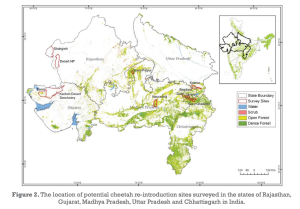Cheetah Reintroduction Plan
Introduction
- Cheetah Reintroduction Plan (CRP) could be the world’s first inter-continental cheetah translocation project.
- The Ministry of Environment had in the 19thmeeting of the National Tiger Conservation Authority (NTCA) released an “Action Plan for Introduction of Cheetah in India”.
- The National Tiger Conservation Authority (NTCA) has decided to bring 50 African cheetahs from Namibia within the next 5 years.
- Population Viability Analysis has shown high probability of long-term cheetah persistence within populations that exceed >50 individuals or when smaller populations are managed as a metapopulation.
- Long term commitment of resources and personnel has been achieved from the Central and State Governments with endorsement from the Union Minister, Government of India and Madhya Pradesh Chief Minister to implement this project successfully.
- The country’s last spotted feline died in Chhattisgarh in 1947.
- Later, the cheetah — which is the fastest land animal — was declared extinct in India in 1952.
- The only mammal to become extinct in India in the last 1,000 years.
- Bringing the Cheetah back will make India the only country with five species of big cats: tiger, lion, leopard, snow leopard and cheetah.
IUCN Status
- African Cheetah – Vulnerable
- Asiatic Cheetah – Critically endangered (Iran)
- The Asian and the African species separated between 30,000 and 60,000 years ago.
Habitat
- Cheetahs dwell on open plains and it is mainly a grassland species.
- Grassland is an essential habitat for biodiversity conservation in India, as many threatened species in India belong to this habitat.
- Cheetah is a flagship species; conserving cheetah will lead to the conservation of all grassland species.
History
- On September 9-10, 2009, a meeting was conducted in Gajner, Rajasthan. Scientists, forest officials, conservationists from India, South Africa, Namibia and other international professionals attended it.
- The meeting concluded with the decision to survey numerous areas in western and central India to establish their potential for introducing cheetahs.
- Former cheetah range states were prioritised, including Gujarat, Rajasthan, Chhattisgarh and Madhya Pradesh.
- In 2010, a report stated that cheetahs might be brought into the Kuno-Palpur Wildlife Sanctuary in Madhya Pradesh, the Shahgarh Landscape in Jaisalmer and the Nauradehi Wildlife Sanctuary in Madhya Pradesh.
- But in May 2012, the Supreme Court of India halted the proposal to introduce foreign cheetahs into the Kuno Palpur sanctuary, fearing they would interfere with an initiative to reintroduce lions into the same sanctuary.
- The court was particularly concerned about whether the African cheetahs would find the refuge a favourable environment in terms of prey abundance.
- In 2020, the Supreme Court lifted a seven-year stay on the experimental introduction of African cheetahs from Namibia into the Indian habitat.
- Finally, in January 2022, an action plan was released to reintroduce the cheetah to India.
Why not Asiatic Cheetah?
- Today Iran is the only remaining home of the Asian cheetah.
- As per the convention on sourcing of animals, sourcing should not be damaging to the survival of the source population, which is a serious issue during such conservation initiatives.
- As it is not viable to source the critically endangered Asiatic cheetah from Iran without damaging this subspecies, India will source cheetahs from Southern Africa.
- South Africa is capable of providing India with a large number of appropriate cheetahs for several years.
- South African cheetahs have the most reported genetic variety among extant cheetah lineages, which is critical for a founding population stock.
- Furthermore, Southern African cheetahs have been determined to be the ancestors of all other cheetah lineages, including those found in Iran.
- As a result, this should be suitable for India’s reintroduction effort for the reasons described above.
But there are issues
- Furthermore, as per many studies, cheetahs in the wild require a broad ecological zone to wander.
- Many campaigners have claimed that the suggested habitats in India are too small to house cheetahs and lack sufficient prey to sustain the large cats.
- The suggested Indian wildlife habitats do not cover more than 1,000 square kilometres and have a considerably lower prey base than cheetah habitats in Africa.
- Moreover, the African cheetah, accustomed to preying on certain species in its natural habitat, would have to relearn how to hunt in India.
Why Kuno Palpur?

Why Kuno Palpur?
- Located in the Chambal region of Madhya Pradesh.
- It is 748 km2 , that is devoid of any human settlements and forms part of the larger Sheopur-Shivpuri dry deciduous open forest landscape spanning an area of 6,800 km2 .
- It currently has leopards, jackals, spotted deer, sambhar, neelgai, chinkara, wild boar and the four-horned antelope, a prey base ideal for felids
- It has ample natural habitat for the cheetah in the form of grasslands, savannah, and open woodland with evergreen riverine ravines.
- Once a cheetah population is established in KNP, reintroduction of the lion or colonization by tigers would not be detrimental for cheetah persistence.
Kuno offers the prospect of housing four large felids of India – tiger, lion, leopard and cheetah to coexist as they did in the past.



